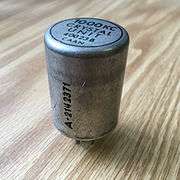Cycle per second
The cycle per second was a once-common English name for the unit of frequency now known as the hertz (Hz). The plural form was typically used, often written cycles per second, cycles/second, c.p.s., c/s, ~, or, ambiguously, just cycles (Cy./Cyc.). The term comes from the fact that sound waves have a frequency measurable in their number of oscillations, or cycles, per second.[1]

With the organization of the International System of Units in 1960, the cycle per second was officially replaced by the hertz, or reciprocal second, "s−1" or "1/s". Symbolically, "cycle per second" units are "cycle/second", while hertz is "Hz" or "s−1".[2] Problems can arise because the units of angular measure (cycle or radian) are omitted in SI.[3][4][5][6]
For higher frequencies, kilocycles (kc), as an abbreviation of kilocycles per second were often used on components or devices. Other higher units like megacycle (Mc) and less commonly kilomegacycle (kMc) were used before 1960[7] and in some later documents.[8] These have modern equivalents such as kilohertz (kHz), megahertz (MHz), and gigahertz (GHz).
The rate at which aperiodic or stochastic events occur may be expressed in becquerels (as in the case of radioactive decay), not hertz, since although the two are mathematically similar, by convention hertz implies regularity where becquerels implies the requirement of a time averaging operation. Thus, one becquerel is one event per second on average, whereas one hertz is one event per second on a regular cycle.[2]
Cycle can also be a unit for measuring usage of reciprocating machines, especially presses, in which cases cycle refers to one complete revolution of the mechanism being measured (i.e. the shaft of a reciprocating engine).
Derived units include cycles per day (cpd) and cycles per year (cpy).
See also

- Cycles per instruction (CPI)
- Heinrich Hertz
- Instructions per cycle (IPC)
- Instructions per second (IPS)
- MKS system of units a predecessor of the SI set of units
- Normalized frequency
- Radian per second
- Revolutions per minute (RPM)
- Turn (angle)
References
- Ewbank, Henry Lee; Lawton, Sherman Paxton (1940). Projects for Radio Speech: A Manual for the Student. New York: Harper & Brothers. p. 151.
- Taylor, Barry N.; Thompson, Ambler, eds. (2008). International System of Units (SI) (PDF). Special Publication. 330 (2008 ed.). Gaithersburg, MD: National Institute of Standards and Technology. p. 27. Retrieved 2019-09-02.
- Mohr, J. C.; Phillips, W. D. (2015). "Dimensionless Units in the SI". Metrologia. 52 (1): 40–47. arXiv:1409.2794. Bibcode:2015Metro..52...40M. doi:10.1088/0026-1394/52/1/40.
- Mills, I. M. (2016). "On the units radian and cycle for the quantity plane angle". Metrologia. 53 (3): 991–997. Bibcode:2016Metro..53..991M. doi:10.1088/0026-1394/53/3/991.
- "SI units need reform to avoid confusion". Editorial. Nature. 548 (7666): 135. 7 August 2011. doi:10.1038/548135b. PMID 28796224.
- P. R. Bunker; I. M. Mills; Per Jensen (2019). "The Planck constant and its units". J Quant Spectrosc Radiat Transfer. 237: 106594. doi:10.1016/j.jqsrt.2019.106594.
- Grammer, George (January 1933). "Rationalizing the Autodyne". QST. West Hartford, CN: American Radio Relay, Inc. XVII (1): 11. Retrieved 2019-09-02.
The 7000- and 14,000-kc. grid coils are wound with No. 18 enameled wire...
- Guentzler, Ronald E. (April 1967). "The "Monode" Noise Generator". QST. West Hartford, CN: American Radio Relay, Inc. LI (2): 30. Retrieved 2019-09-02.
The Monode described here is usable at frequencies below 144 Mc. with slight modification.